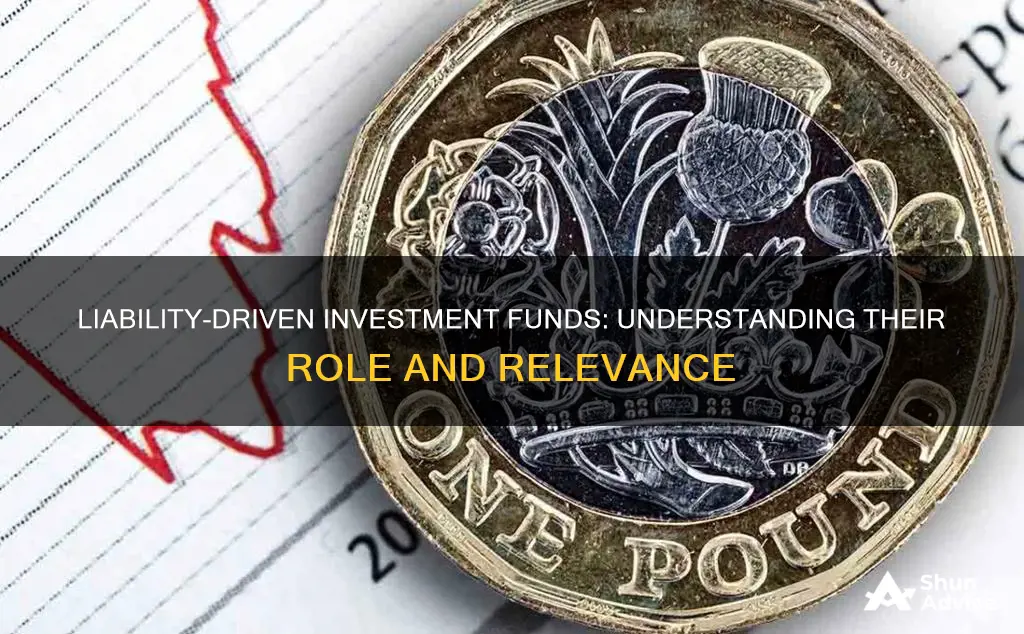
Liability-driven investment (LDI) funds are investment strategies that focus on matching the current and future liabilities of a pension plan. LDI funds are designed to ensure that investors with long-term financial commitments, such as pension funds or insurance companies, have the income-generating assets they need to meet their financial obligations. The goal of LDI funds is to generate cash flow from assets that matches the cash flow required by liabilities, while minimising risks associated with interest rate fluctuations and market volatility. LDI funds are commonly used by pension funds and insurance companies to guarantee future payouts to beneficiaries and policyholders, respectively. These funds are also used by individual investors, such as retirees, to ensure they have sufficient income to cover their living expenses. LDI funds typically invest in assets such as inflation-linked bonds, derivatives, and infrastructure projects, which provide stable and predictable cash flows.
What You'll Learn

LDI is a pension risk management strategy
LDI strategies involve analyzing and managing the risks associated with interest rate fluctuations, inflation, and market volatility, which can impact a pension plan's ability to fulfill its promises to members. By using hedging strategies and investing in assets such as inflation-linked bonds, derivatives, and infrastructure, LDI aims to stabilize the funded status of the pension plan and minimize the impact of the pension plan on the organization's financial health.
The success of an LDI strategy is measured by its ability to gain enough assets to cover current and future liabilities, improve the funded status, and reduce the volatility of the funded status relative to prior strategies. It is important to note that LDI is not a one-size-fits-all solution, and the specific approaches may vary depending on the circumstances of the pension plan and the organization.
LDI has gained prominence due to regulatory and accounting changes, such as the requirement for companies to disclose the funding position of their pension funds on their balance sheets. By adopting LDI strategies, pension plans can improve their overall portfolio outcomes and better manage the risk of not meeting their financial obligations.
LDI strategies are designed to be flexible and evolve as the needs of the pension plan and the market conditions change. This includes considering factors such as interest rate expectations and making adjustments to the asset allocation strategy over time. Overall, LDI is a comprehensive approach to pension risk management that aims to provide better financial outcomes for both plan sponsors and their participants.
Hedge Funds: Banking's Exclusive Investment Club
You may want to see also

LDI is a holistic investment methodology
Liability-driven investment (LDI) is a "holistic" investment methodology. This is because it purports to associate both sides of the balance sheet in the investment process. In other words, it involves managing the risks of interest rate fluctuations and market volatility.
LDI is an investment strategy based on the cash flows needed to fund future liabilities. It is sometimes referred to as a "dedicated portfolio" strategy. It differs from a "benchmark-driven" strategy, which focuses on achieving better returns than an external index. LDI is designed for situations where future liabilities can be predicted with some accuracy.
For individuals, a classic example would be a retiree who needs to estimate the income they will require each year in the future. They would then deduct any other income, such as Social Security payments, to determine how much they will need to withdraw annually from their retirement portfolio. These withdrawals become the liabilities that the investment strategy targets.
For companies, a classic example would be a pension fund that must make future payouts to pensioners over their expected lifetimes. A pension fund following an LDI strategy focuses on the pension fund assets in the context of the promises made to employees and pensioners (liabilities). This is in contrast to an approach that focuses purely on the asset side of the pension fund balance sheet.
LDI strategies involve hedging, in whole or in part, the fund's exposure to changes in interest rates and inflation. Historically, bonds were used as a partial hedge for these interest rate risks, but the recent growth in LDI has focused on using swaps and other derivatives.
LDI is a popular product sold by asset managers such as BlackRock, Legal & General, and Schroders to pension funds. It has worked well in times of steady markets and rates but has struggled when markets move suddenly.
Special Purpose Fund: A Guide to Investing Wisely
You may want to see also

LDI is a dedicated portfolio strategy
A retiree following an LDI strategy will first estimate their required income for each future year. After accounting for social security payments and any other income sources, they can determine the yearly withdrawals needed from their retirement portfolio. These withdrawals become the liabilities that the investment strategy targets.
The LDI strategy then involves investing the portfolio to generate the required cash flows to match these withdrawals. This may involve investing in individual bonds, which provide the ability to match the needed cash flows, a strategy known as "cash flow matching".
LDI differs from a "benchmark-driven" strategy, which focuses on achieving better returns than an external index like the S&P 500. LDI is designed for situations where future liabilities can be predicted with reasonable accuracy.
LDI strategies typically involve hedging the fund's exposure to changes in interest rates and inflation, often using swaps and other derivatives. These strategies aim to stabilise the funded status of the plan and reduce the impact of the pension plan on the organisation's financial health.
Mutual Fund Investment: Is It Right for You?
You may want to see also

LDI is designed for situations where future liabilities can be predicted
Liability-driven investment (LDI) is an investment strategy based on the cash flows needed to fund future liabilities. It is designed for situations where future liabilities can be predicted with some degree of accuracy.
For individuals, the classic example would be the stream of withdrawals from a retirement portfolio that a retiree will make to pay living expenses from the date of retirement to the date of death. This involves estimating the income needed each year in the future and subtracting any social security payments or other income sources. The remaining amount must be withdrawn from the retirement portfolio annually to meet the individual's income needs.
For companies, the classic example is a pension fund that must make future payouts to pensioners over their expected lifetimes. A pension fund following an LDI strategy focuses on the pension fund assets in the context of the promises made to employees and pensioners (liabilities). This is in contrast to an approach that focuses purely on the asset side of the pension fund balance sheet.
LDI strategies involve managing the risks of interest rate fluctuations and market volatility. This can include hedging strategies using derivatives, such as interest rate swaps, to safeguard the value of a portfolio from interest rate movements. The objective is not necessarily to achieve high returns but rather to generate a return from assets that matches the financial obligations of liabilities.
LDI offers a "holistic" investment methodology by associating both sides of the balance sheet in the investment process. It provides a means to manage the risk of not meeting financial obligations and shifts the focus from simply beating benchmarks to improving and stabilizing the funded status of the plan.
KiwiSaver Investment Funds: Where Does Your Money Go?
You may want to see also

LDI strategies involve hedging
LDI strategies may protect pension plans from market risks and enhance long-term financial stability. They can also be used to manage the interest rate exposure of cash balance retirement plans.
LDI strategies can be tailored to a client's current situation and designed to evolve as their needs progress. This involves understanding the client's situation, analysing and modelling key risk factors, constructing a liability benchmark, selecting an appropriate asset allocation strategy, defining non-LDI assets as return-seeking assets, and implementing and monitoring the asset allocation strategy.
Interest rate hedging involves using financial instruments such as financial futures or interest rate swaps to safeguard the value of a portfolio from the effect of interest rate movements. For example, an interest rate swap can exchange a fixed interest rate for a floating rate or vice versa to reduce a portfolio's exposure to changes in interest rates.
To counteract the value-eroding effect of inflation, a portfolio can include investments such as inflation-linked bonds, real estate, and infrastructure. These assets can perform well during periods of increasing inflation and protect portfolio returns.
Funds for Down Payment: Invest or Save?
You may want to see also
Frequently asked questions
Liability-driven investment funds (LDI) are investment funds that focus on generating cash to meet current and future financial obligations (liabilities). The goal is to match the cash flow generated by assets to the cash flow required by liabilities, ensuring that long-term financial commitments are met.
Liability-driven investment funds are commonly used by pension funds and insurance companies that need to guarantee payouts to beneficiaries and policyholders. Individual investors, such as retirees, can also use LDI strategies to ensure they have sufficient income to cover their living expenses.
LDI funds invest in assets that can provide the necessary cash flow to meet financial obligations. These assets may include inflation-linked bonds, derivatives for hedging purposes, and infrastructure projects. The focus is on stabilising the funded status of the plan and minimising risks such as interest rate fluctuations and market volatility.
Liability-driven investment funds help to ensure that financial obligations are met by matching assets to liabilities. They provide a stable source of income for pension funds, insurance companies, and individuals. LDI funds also help to minimise risks and protect against market volatility and interest rate changes.
One disadvantage of liability-driven investment funds is that they typically offer lower returns compared to riskier investments. The focus of LDI funds is on generating stable income to meet financial obligations rather than maximising returns. As a result, they may not be suitable for investors seeking higher returns who are willing to take on more risk.







